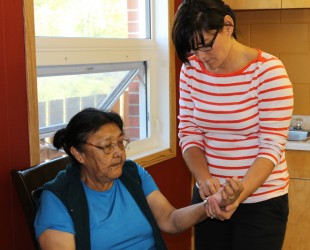Article Origin
Volume
Issue
Year
When it comes to developing health programs – and other services – historically, the Aboriginal population is the last to be addressed, says a health official.
“One of the challenges of our health system across the country is that, unfortunately, we don’t look at seniors and include Aboriginal seniors with the language needs and cultural needs and just basic needs in the same way as we do with other people. It’s often an add-on,” said Dr. Catherine Cook, a physician administrator with the Winnipeg Regional Health Authority and associate dean with the University of Manitoba.
Cook is hopeful that the report recently released by the Health Council of Canada (HCC) will help highlight both the challenges facing Aboriginal seniors, as well as the steps that have been taken by Aboriginal organizations, to meet the unique needs of seniors.
“We’re really hopeful that this report will raise the issue in a timely way so it’s part of the mainstream planning and not an add-on,” said Cook, who is also a councillor on HCC.
Entitled Canada’s most vulnerable: improving health care for First Nations, Inuit and Metis seniors, the report is the last in a series of three undertaken by the HCC on Aboriginal communities. Cook said the organization wanted to study a continuum of Aboriginal health care so produced earlier reports on maternal/child health and urban Aboriginal health care.
This latest report highlights the disparities that exist between health care for Aboriginal seniors and non-Aboriginals. The report states that “First Nations, Inuit, and Métis seniors are among Canada’s most vulnerable citizens… (with) health needs … magnified by determinants of health such as poverty, poor housing, racism, language barriers, and cultural differences.”
The report also targets funding disparity and confusion over service delivery between the federal and provincial/territorial governments as reasons for the poor health conditions many Aboriginal seniors continue to live in.
Cook, who spent most of her career working in public health, says nothing revealed in the report surprised her.
The number of seniors is growing in Aboriginal communities and most live with multiple chronic disease.
“We felt it was important to raise the flags for our seniors,” she said.
The report identifies the gaps between the provincial system of health care and the federal systems of responsibilities for Aboriginal peoples, noting that there isn’t always a smooth and seamless transition between service levels.
Isolation is also a key factor when it comes to access to appropriate levels of care.
Cook said HCC highlighted a number of community organizations in order to stress that, despite the lack of clear government authority and isolation, the needs of Aboriginal seniors can be met effectively.
“The majority of projects that work very well actually address those issues at the very beginning,” said Cook. “(They) had really strong leadership, good communication, and a willingness to address the issue.”
The First Nations Elder Care Course, delivered on-line by Saint Elizabeth First Nation, Inuit and Métis Program, headquartered in London, Ont., is one program highlighted by the HCC. Marney Vermette of the Lac Seul First Nation, and Janetta Soup of the Blood Tribe, provided the cultural context for the professional development course while Saint Elizabeth provided the clinical aspect. The funding to develop and deliver the course came through the foundation at Saint Elizabeth, a non-profit society.
“Our main focus is to work in partnership with communities, so it’s always at the grassroots level,” said Vermette. Elders were consulted in its development and First Nations health care workers reviewed the course prior to its release to ensure it was culturally appropriate, met their learning needs and “met the realities of the community.”
The program has been in operation for almost a year and the feedback has been positive.
“I’ve worked in the north,” said Vermette, who is a registered nurse. “I know the barriers to receiving education in community can be very challenging. To have this available and especially to have it at no cost and to have this information that’s First Nation-focused and culturally appropriate, I’m so very proud that in my career I feel it can be making a difference in that way.”
Cook said it is HCC’s hope that the report not only highlights the gaps, but also provides some strategies to improving health care for Aboriginal seniors.
“I don’t think we do a good job at looking at the end result. If we had fully integrated care, seamless access to health care, good outcomes, ultimately you spend significantly less in health care whether you’re provincial or federal government,” she said.
- 3169 views

